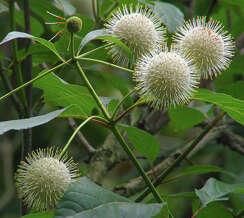Rain Gardens



Houston Chronicle Article
September 20, 2012
By Chris LaChance
There are many reasons to create landscapes in our yards—to add softness to the harsh angles of a home, to make the transition from the natural environment to the built environment appear more seamless, to abide by deed restrictions for foundation planting or simply to foster a passion for gardening. What if these same landscapes could serve important functions; going beyond aesthetics? What if they could help protect water quality, recharge groundwater and provide habitat for wildlife? If this seems like a tall order, that is exactly what rain gardens can do. And a rain garden can fit into almost any landscape.
First, a little background. In undeveloped areas, rainwater, also called stormwater soaks into the soil, provides water for plants and moves the remaining water way below the surface, also known as groundwater recharge. It is filtered by the plants and soil before it enters rivers, streams, bayous or lakes. As we develop the land, however, we create lots of impervious surfaces (places where water cannot penetrate), like parking lots, roadways, roofing and sidewalks. These cause water to runoff more quickly–not allowing for much absorption–and to arrive at the nearest body of water in greater volume—contributing to flooding. The runoff often carries with it things that pollute our waterways such as synthetic fertilizers and pesticides, soil from erosion, oil and grease from cars, and pet waste. We created the problem but perhaps landscaping an area as a rain garden just might be a beautiful solution to effectively managing stormwater where it falls.
A rain garden is a shallow excavated area in the soil (think bowl-shaped), planted as a garden and designed to capture rainfall from impervious surfaces. The stormwater pools for a period of time, slowing the flow and allowing some of it to soak into the soil. The rest of the stormwater is filtered through the plant material, soil and mulch. This allows us to keep more of the rain that falls on our yards while the stormwater that finally enters the stormdrain is cleaner. Planted with native plants, specifically those indigenous plants that can tolerate wet and dry conditions, a rain garden can also function as a habitat for wildlife such as birds and butterflies. When designed properly, water in the rain garden should stand for no more 24 to 48 hours, too short a period for mosquitos to breed.
Location of a rain garden can be anywhere; however, careful evaluation is necessary to make sure it slopes gently away and is at least ten feet from the foundation of any structure and is free of utility lines. Also notice how and where rainfall moves across the property during a rain event since the rain garden can capture stormwater from many sources such as a roof, from sidewalks and streets, or from a yard.
For more detailed information regarding size, depth and soil mixture, refer to the Texas A&M AgriLife Extension Service publication on rain gardens, https://agrilifelearn.tamu.edu/ and search for rainwater harvesting. Click on the rain garden publication L-5482. The download is free.
Ways to direct the flow to the rain garden can be a downspout, a downspout with a corrugated pipe extension, a swale, which is a shallow ditch, or simply the slope of the yard.
Rain gardens have planting zones. Remember the bowl shape. For the center where water pools the longest, use native plants that can stand wet feet. The sides, the median zone, need those plants that like it wet for a short time. The top edges are the third zone so plants here like it dry most of the time. The plant list is quite long and varied.
Like any other planted area, a rain garden will need regular watering during the critical establishment period, usually one to two years and, thereafter, supplemental watering during extended dry periods. And, as with any garden, proper maintenance is necessary.
Above all, a rain garden is a landscape amenity, blending beauty and function—a beautiful, WaterSmart solution to water pollution.
Chris LaChance is WaterSmart Coordinator for the Texas A&M AgriLife Extension Service and Texas Sea Grant, part of the Texas A&M University System. WaterSmart is funded by a grant from Houston Endowment, Inc. Contact Chris at c-lachance@tamu.edu.
 Texas Community Watershed Partners
Texas Community Watershed Partners 